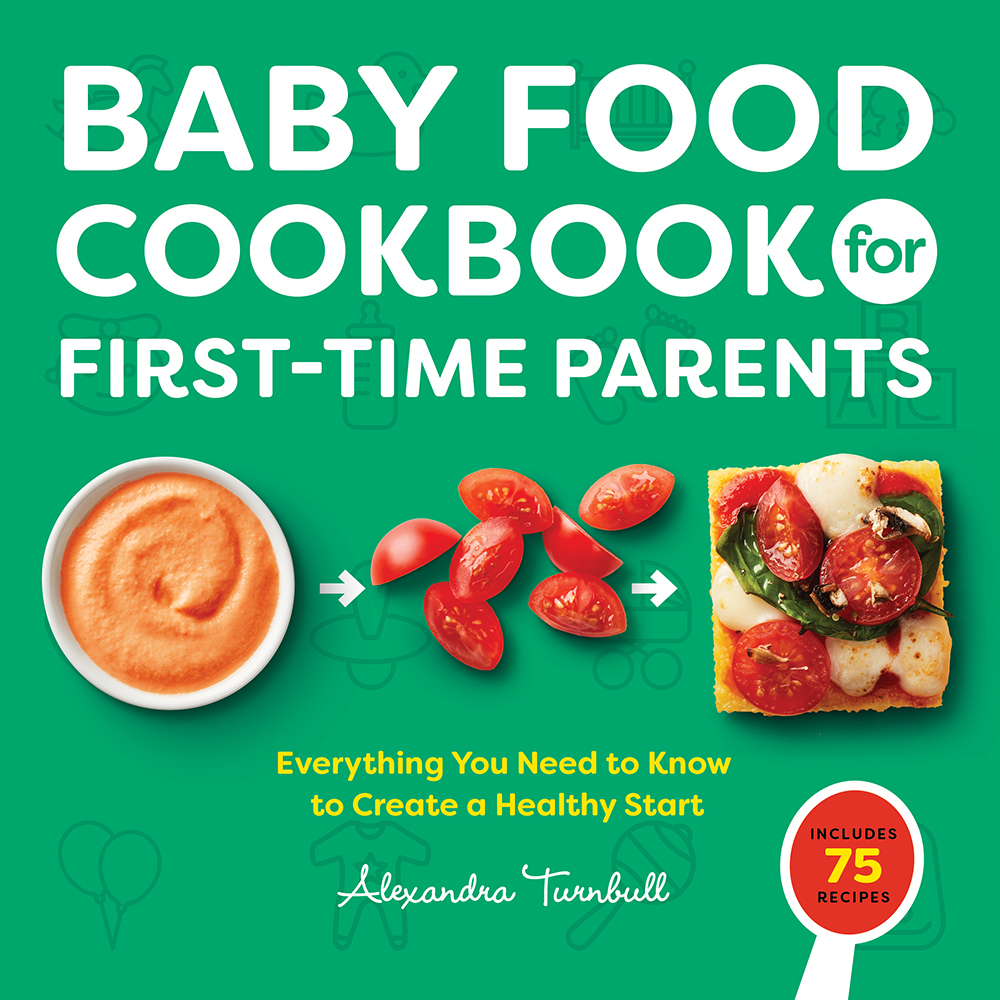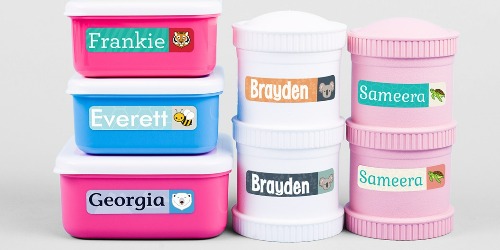This post may contain affiliate links. This article is for informational and educational purposes only and is not/should not be used for medical advice. If you’re concerned about your child’s mental, emotional, or physical health, always speak with your child’s health care team.
Both my daughter (6 at the time) and myself (34 at the time) were diagnosed with ADHD. Receiving these diagnoses for both of us has been extremely helpful, yet challenging at the same time.
Through our ADHD diagnosis journey, we’ve learned a lot about one another, but most importantly, how to manage our symptoms.
As a dietitian, I naturally thought about how food impacts our brain and what would be the best nutrients for ADHD and picky eating to help manage some of the symptoms that come along with this neurodevelopmental disorder.
In this blog post, I provide a general overview of ADHD, but also the best nutrients for ADHD and picky eating, including specific foods, and supplements to consider prioritizing for your picky eater.
As always, speak to your child’s health care provider regarding any diagnoses, treatments, supplementation or questions regarding their health and wellness. This information is not to be used for medical purposes.
Table of Contents
What is ADHD
Attention-Deficit/Hyperactivity Disorder, also known as ADHD, is a neurodevelopmental disorder relating to inattention, hyperactivity, and/or impulsivity and is found in 9.8% of children ages 3 to 17 years of age.
While everyone has trouble focusing from time to time, people with ADHD have trouble so frequently that it negatively impacts their daily life, relationships, and academics/work.
Those diagnosed with ADHD have difficulties with some or all of the following:
- Paying attention
- Attention to detail
- Making careless mistakes
- Trouble listening to others
- Difficulty following through with tasks
- Avoiding long or difficult tasks
- Easily distracted
- Forgetful
- Impulsive
- Fidgety
Types of ADHD
There are three different types of ADHD; inattentive, hyperactive-impulsive, and a combination of both.
Inattentive ADHD
ADHD with inattentive behaviors typically presents itself when the individual has difficulty finishing a task, paying attention to details, and is easily distracted or forgetful.
Children with inattentive ADHD are more commonly girls and are often underdiagnosed simply because their behaviors are not as often a disruption at home or in the classroom.
Inattentive ADHD Symptoms
- Paying attention in general
- Attention to detail
- Making careless mistakes
- Trouble listening to others
- Difficulty following through with tasks
- Avoiding long or difficult tasks
- Easily distracted
- Forgetful
Hyperactive-Impulsive ADHD
When an individual has ADHD with hyperactive-impulsive behaviors, they typically are mislabeled as ‘naughty’ due to their high energy, frequency of interruptions, and inability to control their body at times.
Hyperactive-Impulsive ADHD Symptoms
- Fidgeting or difficulty sitting still
- Moving around when expected to sit
- Climbing
- Loud
- Feels as if driven by a motor
- Talks excessively
- Interrupts
- Difficulty waiting one’s turn
Combined ADHD
The most common form of ADHD is a combination of both inattentive and hyperactive-impulsive. This is where an individual presents with a variety of the types of ADHD, limiting their ability to focus.
Causes of ADHD
The cause of ADHD is still unknown, however it’s likely multifactorial with genetics playing a large role. Research is starting to explore the impact of brain injuries, nutrition, and social environments as well.
While many believe that sugar, television, and parenting styles may be the cause of ADHD, the research does not support these theories. These factors may play a role, but alone are not the cause of ADHD.
Diagnosing ADHD
The process for diagnosing your child with ADHD will depend on your child’s health care provider, age, and history of symptoms. It can be as simple as using surveys, such as the Vanderbuilt form, from teachers and parents, or as in depth as psychological assessments.
There is no single test that will automatically identify ADHD, but rather a variety of information provided by parents, teachers, other adults, and the child themselves over a significant period of time, typically six months or more, to identify trends that may be associated with ADHD.
It’s also important to know that ADHD looks different in each person.
Treatment for ADHD
As with any illness, disorder, or disease, there’s no magic fix.
There’s typically a combination of treatments used to help manage symptoms for ADHD such as therapy, medication, supplementation, and even lifestyle changes that may include prioritizing or avoiding certain foods.
Lifestyle Changes to Help Manage ADHD:
- Eating a balanced diet
- 60 minutes of physical activity per day
- Adequate sleep
- Limiting screen time.
These lifestyle changes aren’t just helpful for managing ADHD, but living a healthy lifestyle in general.
Sometimes lifestyle changes are not enough alone to help manage ADHD symptoms and medication, therapy and supplementation may need to be considered.
Always speak to your child’s health care provider regarding the best treatment plan.
ADHD and Picky Eating

ADHD and picky eating can go hand in hand if you really think about it.
A child who has ADHD may have a difficult time focusing at mealtimes, making it challenging to either stay at the table, engage with foods, or focus on the food in front of them in general.
Many medications used to help manage ADHD symptoms are also appetite suppressants, which can put your child at risk for weight loss and nutrient deficiencies.
The combination of ADHD and picky eating can make mealtimes challenging for both the parents and the child.
While we want to make sure we’re providing healthy options to our children, when you have a picky eater, this isn’t always as simple as one might think.
Focusing on the foods your child enjoys, while also trying to prioritize a few key nutrients for ADHD and picky eating can be helpful.
Nutrients to Prioritize with ADHD
Many studies have evaluated the impact of diet and ADHD, however results are conflicting and the associations between ADHD and single nutrient intake are inconsistent.
The best nutrients for ADHD include protein, iron, omega-3 fatty acids, vitamin D, and magnesium.
Keep in mind that there’s no one single nutrient that will be a quick fix, but instead focus on adding in more nutrient dense foods that support your child’s overall health and simply making sure they’re eating enough.
Protein for ADHD
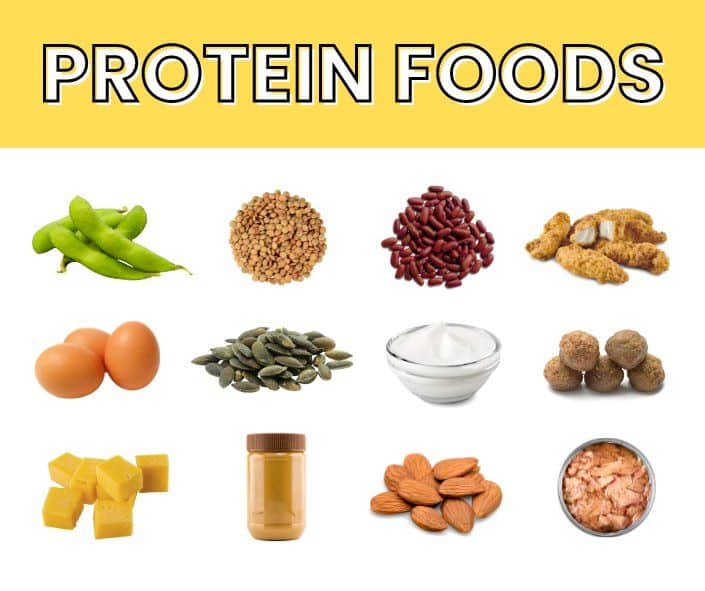
Choosing foods high in protein with each meal and snack not only helps your child feel fuller for longer, but they also transport important nutrients and help build and repair tissues in their body.
The next time your child asks for a snack, try to prioritize a protein with their favorite, carbohydrate-rich snack of choice.
Protein foods
- Beans
- Lentils
- Nuts
- Nut butters
- Eggs
- Quinoa
- Seeds
- Greek Yogurt
- Cheese
- Cottage cheese
- Milk
- Edamame
- Beef
- Chicken
- Pork
- Fish
- Shellfish
To determine how much protein your child needs, read more here.
Iron for ADHD
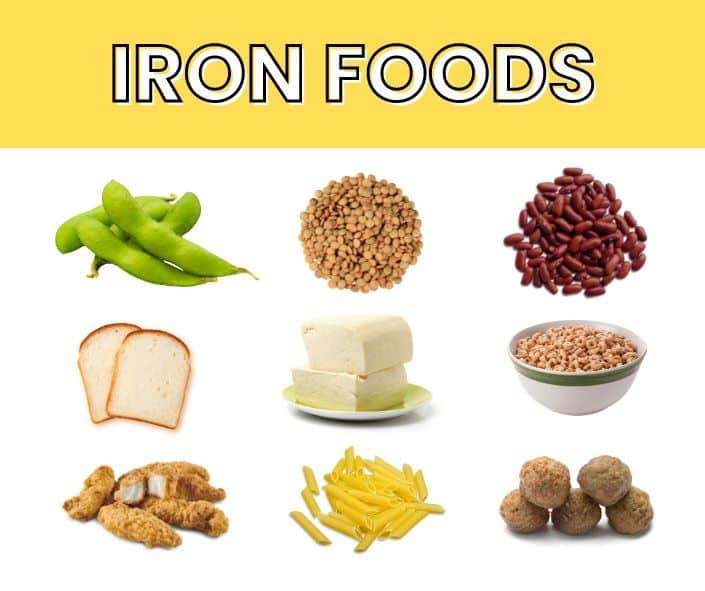
Iron helps transport oxygen to your child’s brain and when they don’t have enough iron in their body, it’s difficult for their brain to function at its best.
Some research has shown that iron deficiencies may be related to ADHD. Therefore, making sure your child consumes enough iron through food can be one of many ways to help manage symptoms of ADHD.
If your child has a difficult time consuming iron-rich foods, consider requesting labs to determine if supplementation is necessary, as some research shows iron supplementation can improve ADHD symptom severity for some children.
To learn more about iron deficiency, how much iron your child needs, and sources of iron, read more here.
It’s common for picky eaters to be below recommended levels of iron.
If you have a picky eater who doesn’t enjoy animal proteins which tend to be one of the best sources of iron, try leaning on fortified whole grain cereals and pastas that will also provide fiber and other valuable micronutrients.
Foods with Iron
- Beef
- Chicken
- Pork
- Beans
- Lentils
- Tofu
- Edamame
- Fortified grains such as cereals, pasta, breads, etc
- Lentil & chickpea pasta
Iron Supplements for Kids
Always speak to your child’s pediatrician prior to taking supplements. Look for supplements that have been third party tested.
- Renzo’s Iron Strong with Vitamin C
- NovaFerrum Chocolate Liquid Iron
- Carlson Kid’s Chewable Iron
- Mary Ruth’s Vegan Liquid Iron
Omega-3 Fatty Acids and ADHD
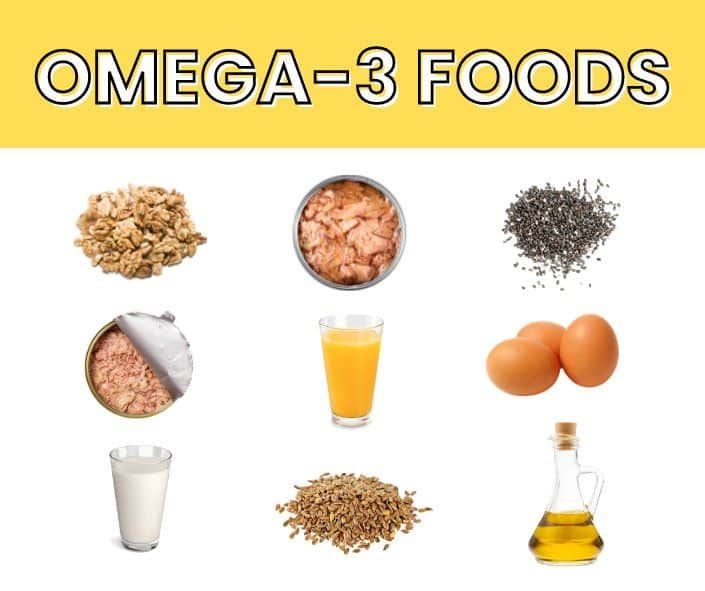
Omega-3 fatty acids are a group of healthy fats that play a vital role in your child’s overall health, specifically their brain health. Our body cannot make omega-3s and therefore we must get them from our diet.
The three different omega-3s include alpha-linolenic acid (ALA), docosahexaenoic acid (DHA), and eicosapentaenoic acid (EPA).
ALA, found in plant sources like flaxseeds and walnuts, must be converted into DHA and EPA, but this process is inefficient—only a small percentage actually becomes usable. Since DHA and EPA, found in fatty fish, are crucial for brain function and kids with ADHD may have lower levels, prioritizing these sources directly is more effective for supporting attention and behavior.

It’s possible that omega-3s, even supplementation, may help many common ADHD symptoms such as hyperactivity, impulsiveness, restlessness, and aggression. However, some research doesn’t support this, therefore more research is needed.
Again, for children with ADHD and picky eating, especially those who are taking medication, the most important thing is that they are eating enough.
Prioritizing foods with omega-3s, specifically DHA and EPA, can not only help ensure they’re getting enough calories, but also valuable nutrients for their brain.
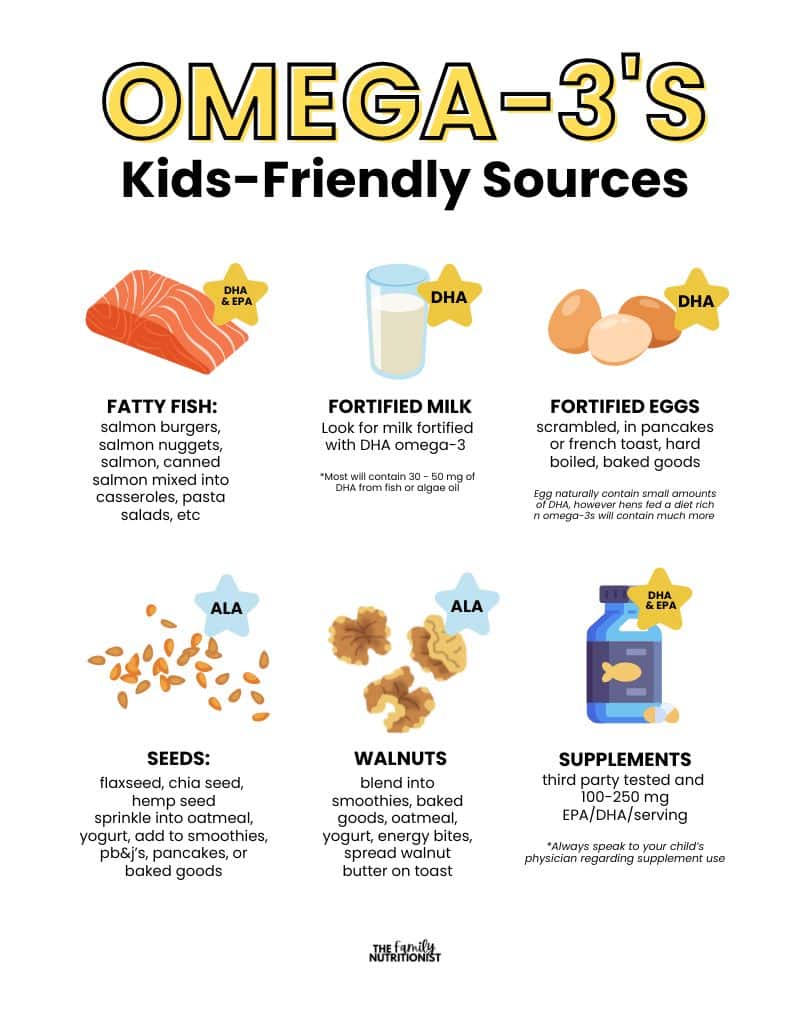
Foods with Omega-3’s
- Walnuts
- Brazil nuts
- Ground flaxseed
- Chia seeds
- Olive oil
- Salmon
- Mackerel
- Tuna
- Herring
- Sardines
- Fortified eggs, yogurt, juice, milk and soy beverages
If your child doesn’t frequently consume foods with Omega-3’s, you may want to discuss with their healthcare provider the use of supplementation.
Other high fat foods to consider:
- Whole milk/full fat dairy products
- Butter
- Nuts
- Nut butters
Omega-3 Supplements for Kids
Omega-3 supplements can sometimes taste fishy, making it hard for many kids to tolerate, especially picky eaters.
When choosing an omega-3 supplement, look for one with DHA and EPA instead of just ALA—otherwise, you’re relying on your body to do a job it’s not great at, like asking a toddler to neatly pour their own milk.
If your child doesn’t like a particular supplement, it’s of no use. Find a supplement in whatever form or flavor your child enjoys. And as always, speak with your child’s pediatrician prior to starting any supplements. Look for supplements that have been third party tested.
Here are a few brands that have third-party testing to ensure safety and purity and also contain at least 100 mg or more of EPA and DHA content per serving:
- Nordic Naturals Children’s DHA – soft gels, chewable, liquid, vegetarian
- Barlean’s Omega Pals – liquid
- Garden of Life Kids – liquid
- Carlson Kids Fish Oil – liquid
- OmegaVia Kids Omega-3 – chewable
- Nature’s Craft Omega 3 + DHA – drops
Vitamin D and ADHD

According to the American Academy of Pediatrics, 42% of Americans are deficient in vitamin D. They also state that most children will not meet their Vitamin D needs through food alone.
Throw in a picky eater who’s on an appetite suppressing medication, and the odds of them meeting their vitamin D needs through food are even less.
Vitamin D is a fat-soluble vitamin that helps you child’s body absorb certain minerals, specifically calcium. It also plays an important role in communication between their brain and their body.
Some research has identified that vitamin D supplementation may show a small, but statistically significant improvement in ADHD scores.
As with many studies regarding diet and ADHD, more is needed to be done.
Sources of Vitamin D
- Fortified milk (3 mcg vitamin D per 8 oz)
- Fortified foods like breakfast cereal, orange juice, and yogurt
- Fatty fish such as trout, salmon, tuna, and mackerel
- Beef liver, egg yolks, cheese (small amounts)
- Mushrooms
- Sun exposure outside (although it’s recommended to limit how much time you spend in the sun due to UV rays and skin cancer).
Tinysprouts Milled Flaxseed has added Vitamin D and is easy to mix into picky-eater friendly foods like peanut butter and jelly sandwiches, baked goods, French toast, and no bake bliss balls.
For information on daily vitamin D recommendations, read more here.
If it’s determined by your child’s health care provider that a vitamin D supplement may be beneficial, consider getting vitamin D3, as it’s likely more effective.
However, you can get too much vitamin D. Symptoms of excess vitamin D include nausea, vomiting, muscle weakness, confusion, pain, loss of appetite, dehydration, excessive urination and thirst, and kidney stones.
Vitamin D Supplements for Kids
Always speak to your child’s pediatrician prior to taking supplements. Look for supplements that have been third party tested.
- Renzo’s Dynamite Vitamin D3
- Smarty Pants Kids Multi & Omegas
- L’il Critters Vitamin D3
- Mary Ruth’s Organic Kids Vitamin D3 Liquid Drops
- Nordic Naturals Vitamin D3 Gummies
Magnesium for ADHD
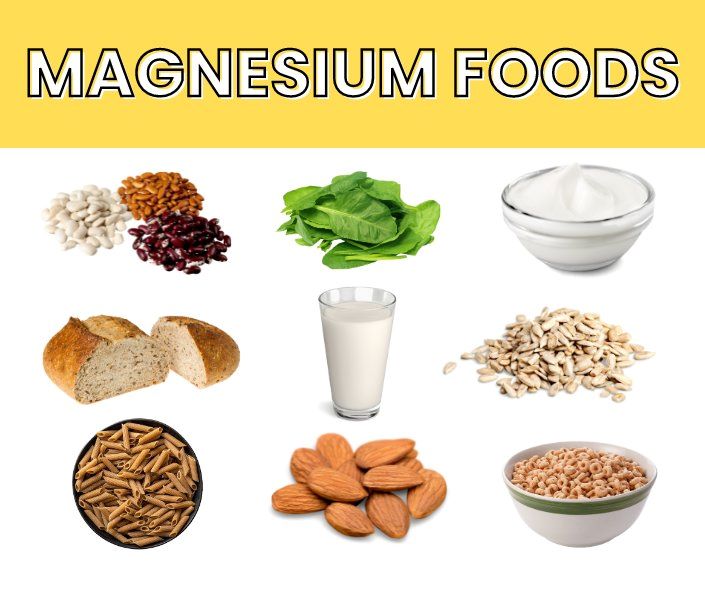
Magnesium is a mineral your child’s body needs to help regulate muscle and nerve function, blood sugar levels, and blood pressure.
Research is conflicting between magnesium and ADHD and more research with larger sample sizes is needed.
However, a clinical trial with 66 children studying the supplementation of magnesium and Vitamin D for 8 weeks showed significant reductions in social emotional behaviors compared to the placebo group.
The best magnesium for ADHD is going to be a more absorbable form such as magnesium aspartate, magnesium citrate, magnesium lactate, and magnesium chloride.
Sources of Magnesium
- Legumes
- Nuts
- Seeds
- Whole grains
- Green leafy vegetables
- Fortified breakfast cereals
- Milk
- Yogurt
Magnesium Supplements for Kids
Always speak to your child’s pediatrician prior to taking supplements. Look for supplements that have been third party tested.
For more information on daily magnesium recommendations, read more here.
Elimination Diets for ADHD
An elimination diet typically consists of eliminating or restricting specific foods or ingredients, such as the common allergens, gluten, histamine, sugar, and food additives, including artificial colorings.
While some research suggests that elimination diets can provide promising results, these diets haven’t been studied long term.
Elimination diets are difficult to stick to over long periods of time, can place a lot of burden on families, and puts children at risk for nutritional deficiencies.
If you have a child with ADHD who is also a picky eater, it’s likely that your child’s diet is already limited. With this in mind, I do not recommend restricting their diet as it can put them at risk for nutritional deficiencies, potentially further impacting ADHD symptoms.
You know your child best, therefore choose foods that your child enjoys, you have access to, and can afford.
And remember, environmental factors can also play a role, but genetics plays the largest role. No diet, ingredient, or food will ‘cure’ ADHD, but may possibly help your child manage their symptoms better.
Ingredients and Foods to Avoid with ADHD
Many people believe that sugar can be the cause of hyperactivity in children, however this has not been proven.
Artificial food colors, like Red No. 40, are also a common concern for causing hyperactivity in children, but again, the research is limited and insignificant. Read more here about the research on Red No. 40 and hyperactivity.
As a dietitian, I believe that research is a helpful tool, however it’s not the end all. If you feel that a particular food or ingredient negatively impacts your child, go with your gut, but also consider to what extent that restricts your child’s diet.
Instead of what you can avoid, focus on how you can add in more beneficial nutrients into your child’s diet for overall better health.
Mealtime Tips for Kids with ADHD and Picky Eating
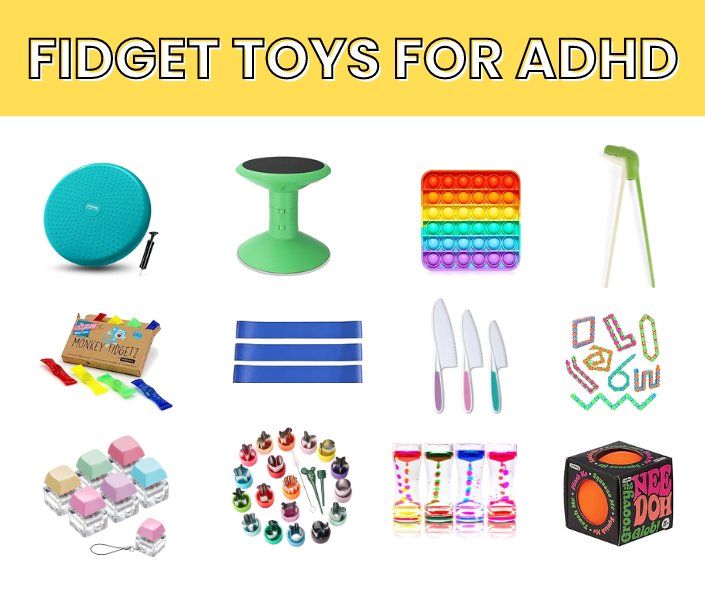
Children with ADHD often have a hard time sitting still at meals. However there are many things you can do to help them funnel that energy so they can focus on fueling their body when it’s time to eat.
You can try letting your child stand, providing them with a foot band for their feet to play with, or a wobble seat to help them wiggle in their seat.
Another option is to provide them with novelty utensils, plates, and other kitchen gadgets to make mealtimes more fun and engaging.
Helpful Mealtime Strategies for Kids with ADHD and Picky Eating
- Let them stand
- Give them a foot band on their chair
- Use a wobble seat
- Provide novelty plates, kitchen gadgets, and utensils, to make meals more engaging
- Let kids cut their own foods with kid-safe knives or mini cookie cutters
- Ask kids to bring a stuffed animal to pretend to feed
- Offer a fidget toy with meals
- Offer chairs for kids with ADHD
Novelty Kitchen Tools
Fidget Toys for ADHD
Meal planning for ADHD and Picky Eating
For parents of children with ADHD, it can be helpful to plan out the menu with your child so they know what to expect and they can be included in what’s available.
Grab the Ultimate Meal Planning Toolkit for Families to help organize and plan out your meals for the week or month!

Conclusion
ADHD is a neurodevelopmental disorder relating to inattention, hyperactivity, and/or impulsivity and is found in 9.8% of children ages 3 to 17 years of age.
The cause of ADHD is still unknown, however it’s likely multifactorial with genetics playing a large role.
ADHD treatment involves a combination of therapy, medication, supplementation, and even lifestyle changes.
A child who has ADHD may have a difficult time focusing at mealtimes, making it challenging to either stay at the table, engage with foods, or focus on the food in front of them in general.
Many studies have evaluated the impact of diet and ADHD, however results are conflicting and the associations between ADHD and single nutrient intake are inconsistent.
The best nutrients for ADHD include protein, iron, omega-3 fatty acids, vitamin D, and magnesium.
Keep in mind that there’s no one single nutrient that will be a quick fix, but instead focus on adding in more nutrient dense foods that support your child’s overall health.
While some research suggests that elimination diets can provide promising results, these diets are hard to stick to over long periods of time, can place a lot of burden on families, and puts children at risk for nutritional deficiencies.
As always, speak to your child’s health care provider regarding any diagnoses, treatments, supplementation or questions regarding their health and wellness. This information is not to be used for medical purposes.
Disclaimer
This article written by Alexandra Turnbull provides information that should not take the place of medical advice. You are encouraged to talk to your health care providers (doctor, registered dietitian, pharmacist, etc.) about your interest in, questions about, or use of dietary supplements and medical treatment and what may be best for you or your child’s overall health. Any mention in this publication of a specific product or service, or recommendation from an organization or professional society, does not represent an endorsement by Alexandra Turnbull of that product, service, or expert advice.


